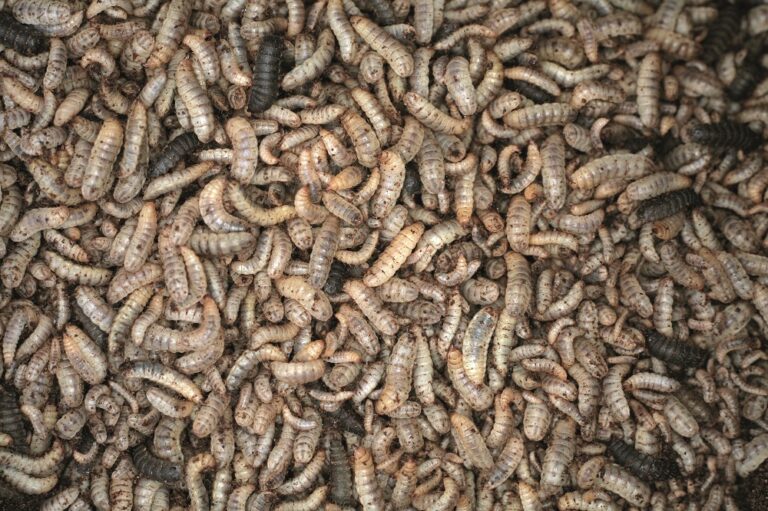Poultry farmers have been pushing government to permit the scaling-up of production and use of insect protein in poultry feed.
In June, a group of companies, industry bodies and research organisations came together to ask the government to support insect protein as a sustainable source of animal feed through public statements and cash investments.
The group, who have formed Insect Biomass Conversion Task & Finish Group, have published a report that makes the case for the UK government to get behind insect biomass conversion. The members say they are committed to collaborating in order to deliver insect production at scale in the UK.
Introducing insect protein to supplement common alternatives like fishmeal or soya provides a more sustainable way to meet UK and worldwide protein needs, avoiding unwanted land use change. In the UK, this innovative new industry could be worth £1 billion, the group claims, generating an estimated 3,300 direct jobs and 600 indirect jobs in just five years.
The NFU is part of the group and its poultry board chairman Thomas Wornham says insect protein was a ‘transformative technology’ that could make a step-change breakthrough in the efficient use of resources in agriculture.
The group’s first UK market report with a number of key recommendations:
- It wants the government to issue a national statement of support
- It urges the government and industry to support a central body that could drive rapid sector development for the UK
- It recommends the government and industry should collaborate to secure dedicated funds to drive market development
- It wants the government to lead on delivering insect biomass legislation and regulation
- Short term fiscal incentives for early adopters should be devised and provided by government.
“Our members are extremely interested in being able to source sustainable alternative proteins from closer to home,” says Wornham. “This is potentially a huge opportunity for the poultry sector and we in the UK should be leading on the development. It potentially cuts our cost of production, gives us access to a very natural supply of quality protein and improves our competitiveness.”
Andrew Swift, chief executive of Fera Science and coordinator of the Insect Biomass Conversion Task & Finish Group says: “Insect protein production can be a big part of the solution to the global protein deficit for sustainable rearing of livestock. This innovative and ‘clean’ industry has huge economic and environmental potential. It is critical that Government acts swiftly to ensure the UK does not lose further ground in this rapidly developing global market.”
The government has already dipped its toe into supporting the development of insect protein as feed. Last year it stumped up £571,166 (through the Innovate UK programme) to support a Cambridge-based business that specialises in ‘insect biomass conversion’. Entomics is rearing black soldier fly larvae on various ‘recipes’ of food waste to determine how each affects the bugs’ growth rates and nutritional profiles. It’s also looking at ‘microbial fermentation technology’, which could mean the livestock feeding on the larvae are more resistant to disease and, in turn, reduce reliance on antibiotics.
Members of the Insect Biomass Task & Finish Group are: Fera Science (lead), Durham University, Entomics, Anpario, AgriProtein, UK FPPA, Zero Waste Scotland, (York, North Yorks, East Riding) LEP, British Poultry Council, Tesco, McDonalds, PFMA, NFU, Entocycle, CIEL, Humphrey Feeds & Pullets, AIC, NPA, Minerva, Multibox, Scottish Aquaculture Innovation Centre and Beta Bugs.
The current state of play
In the EU insect protein is currently permitted for use in pet food and aquaculture, and the species of insect that can be used and the organic substrates that they can be reared on are defined. According to Fera Science, European pet food companies are utilising insect meal, but not from UK insect producers.
Live insects can be fed to poultry, but delivery on a practical scale has not yet been realised European pet food companies are utilising insect meal, but not from UK insect producers.
The increasing demand for meat and fish products (especially in Asia, expected to see 78% increase in meat & seafood demand from 2017 to 2050 according to Asia Research and Engagement) puts pressure on our current animal feed protein sources such as soy and fishmeal. This combined this with the limited availability of fertile land means that increased meat production will have considerable impacts on the environment. Primary protein production needs to increase by 50% until 2050 to meet this demand and today 85% of arable land is already in use.
Insects are able to recover nutrients from organic residues and bring them back into the food value chain, thereby contributing to a circular economy. Since no fertile land is needed for their production, they are a promising and sustainable new source of protein compared to today’s main alternatives. Some insect species, such as the black soldier fly, are well-suited for growth on large scale.


